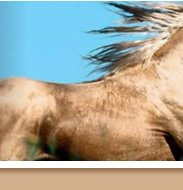![]()
![]()
![]()
![]()
![]()
![]()

![]()
![]()
![]()
![]()
![]()
Barrel Race with Controlled SpeedHere's how to calm your anxious barrel racing horse--and shave seconds off your times. A tie in to the June 2002 issue of Horse & Rider. Does your barrel racing horse dance and fidget at the in-gate--then run past the first barrel? Here are seven tips to calm him down and get his mind on the upcoming pattern. * Check every piece of your equipment to make sure nothing is irritating your horse. Examine your saddle pad to make sure it's free of foreign material (I actually found a nail in a pad once) Check either side of his withers after riding for sore or dry spots; if he seems sensitive in this area, your pad may not be thick enough, or your saddle may not fit properly. Look behind his front legs for any signs of soreness from the cinch rubbing. (I use either a fleece-lined nylon cinch, or one made from mohair and encased in a Toklat cinch cover.) Martha Josey, world champion barrel racer, with her husband R.E. Josey. ©Horse & Rider Make sure your bit isn't pinching the corners of his mouth, and your curb chain isn't causing sores on the sides of his jaws or under his chin. Have your veterinarian or a certified equine dentist check your horse' teeth. If your bit is bumping up against your horse's wolf teeth, the discomfort will make him nervous, causing him to resist your rein cues. * Take your horse off a high-energy grain supplement, but make sure his nutritional needs are met. A horse that doesn't receive proper nutrition can become hyperactive or muscle sore. I've seen many horses calm down after they were put on a balanced diet. * Try riding your horse with a snaffle bit so he has less to fight against, which will help keep him relaxed and supple. * Make schooling rides slow and easy for your horse. Perform flexing and bending exercises to limber him up, keeping him calm and relaxed. * To cure your horse of running past the first barrel, try this exercise: Jog toward the barrel. When you're about one horse-length away, say "whoa." Then take up on your reins, sit down in your saddle, and ask him to walk around the barrel. When he'll do this calmly, move up to loping toward the first barrel, then jogging around it. * Avoid practicing barrels every day; alternate your pattern work with trail riding. (For more information on trail riding with a barrel racing horse, see Horseman's Handbook, Horse & Rider July 2002.) * Stay relaxed. If you need help on your riding, attend a professional horsemanship clinic. I've never seen a horse that wouldn't calm down with the right kind of riding. |
![]()
![]()
©Copyright 2025
Alhaja.net All rights reserved.
Unauthorized duplication in part or whole strictly prohibited by
international copyright law.
![]()



